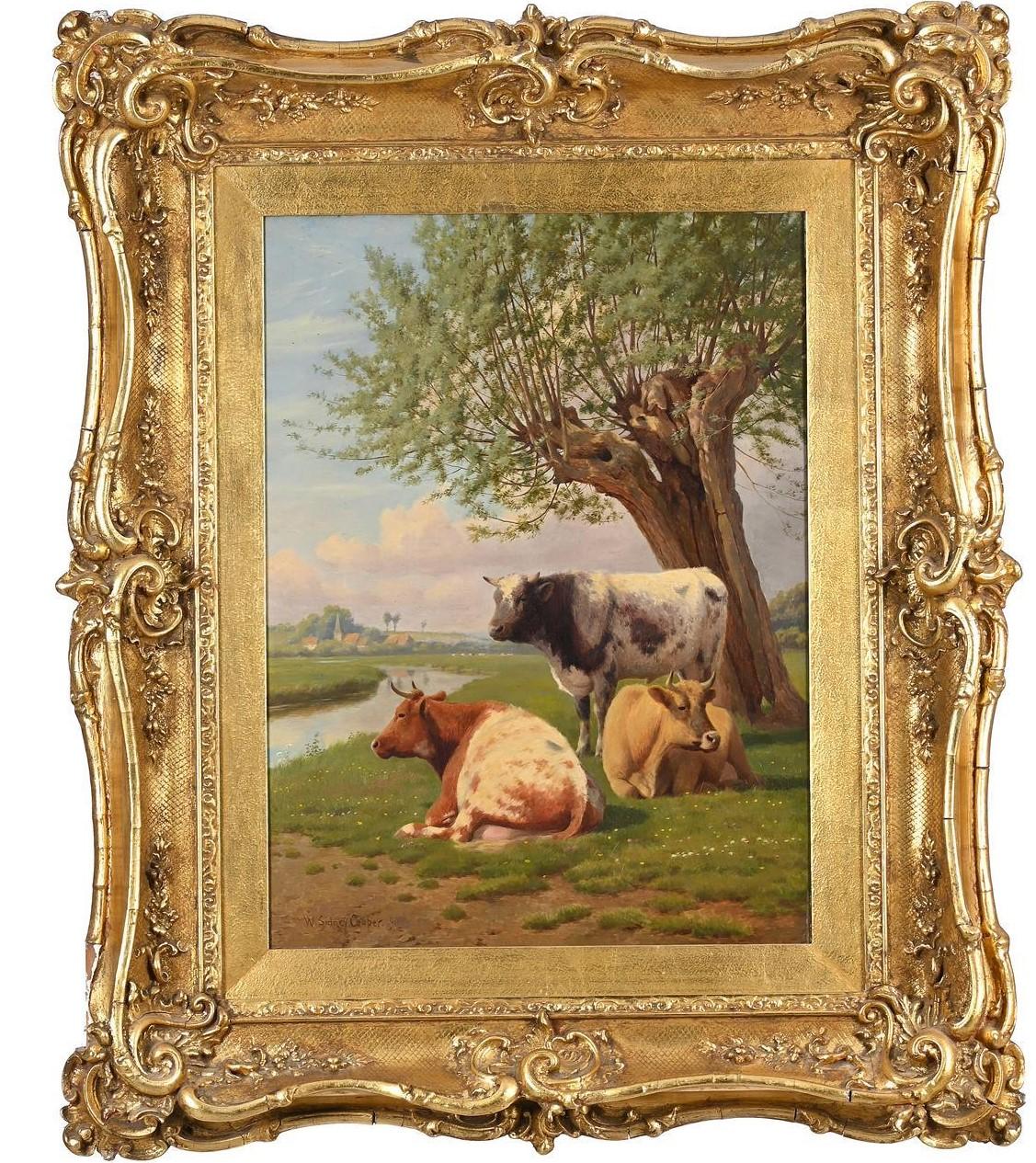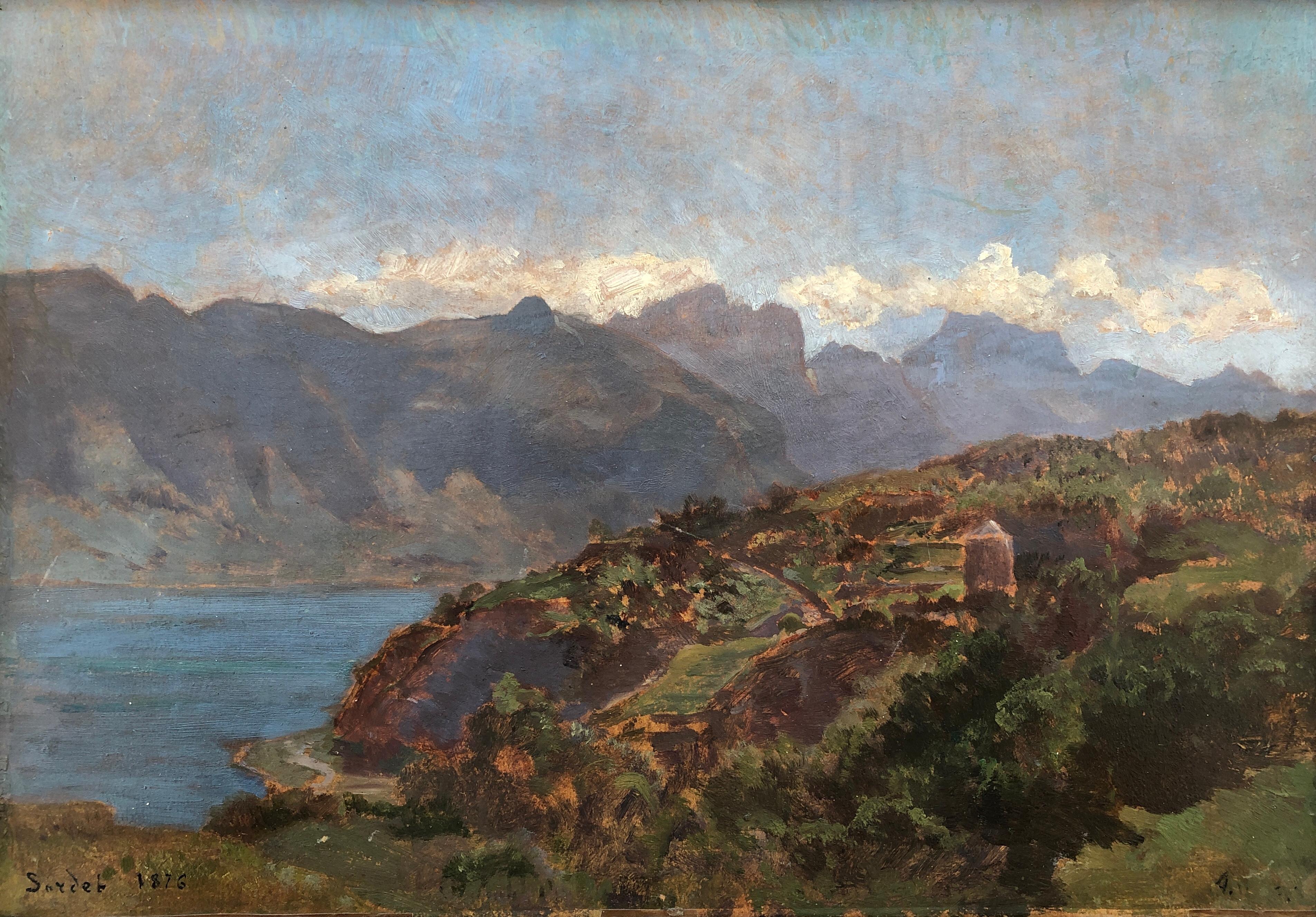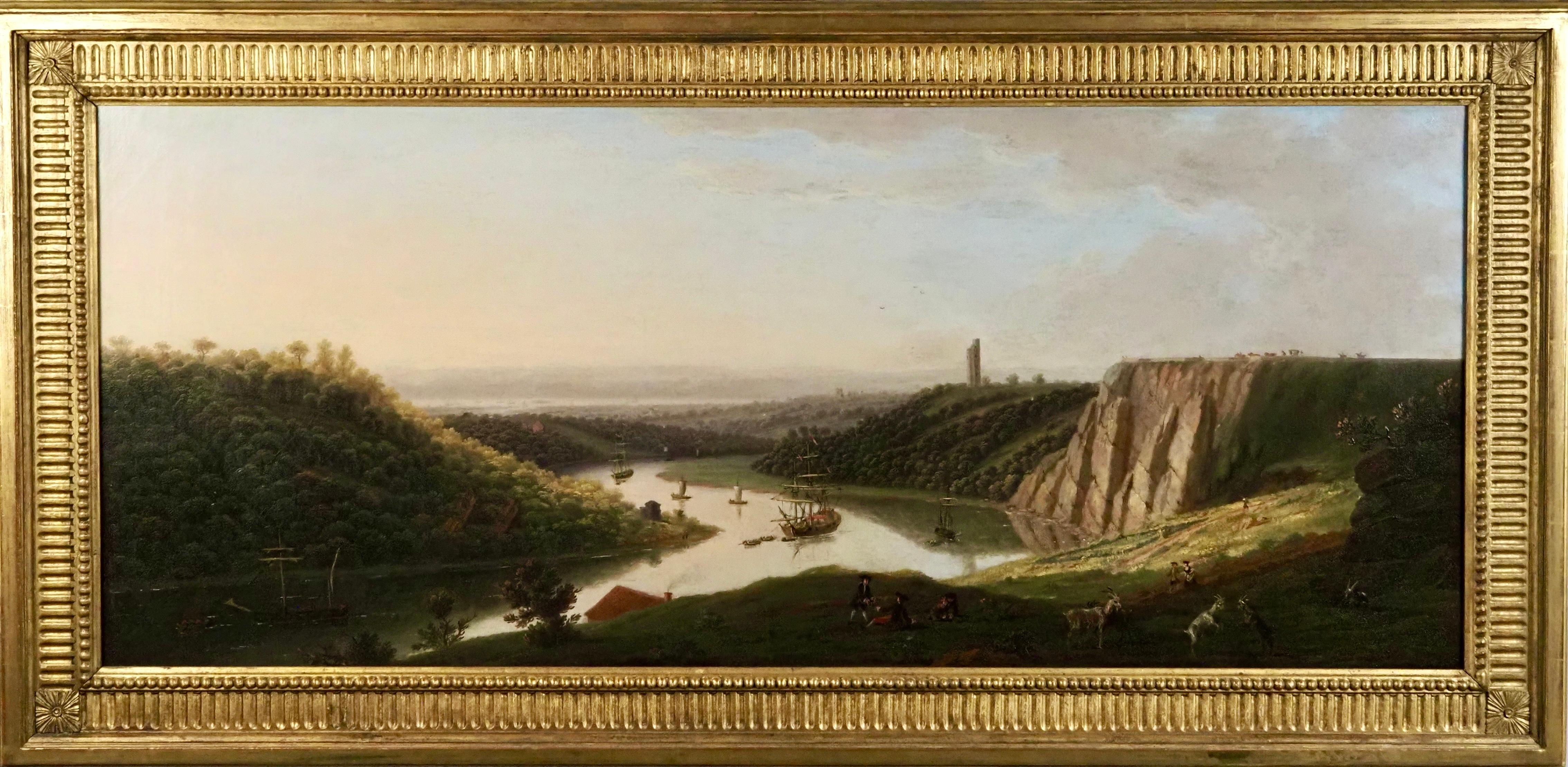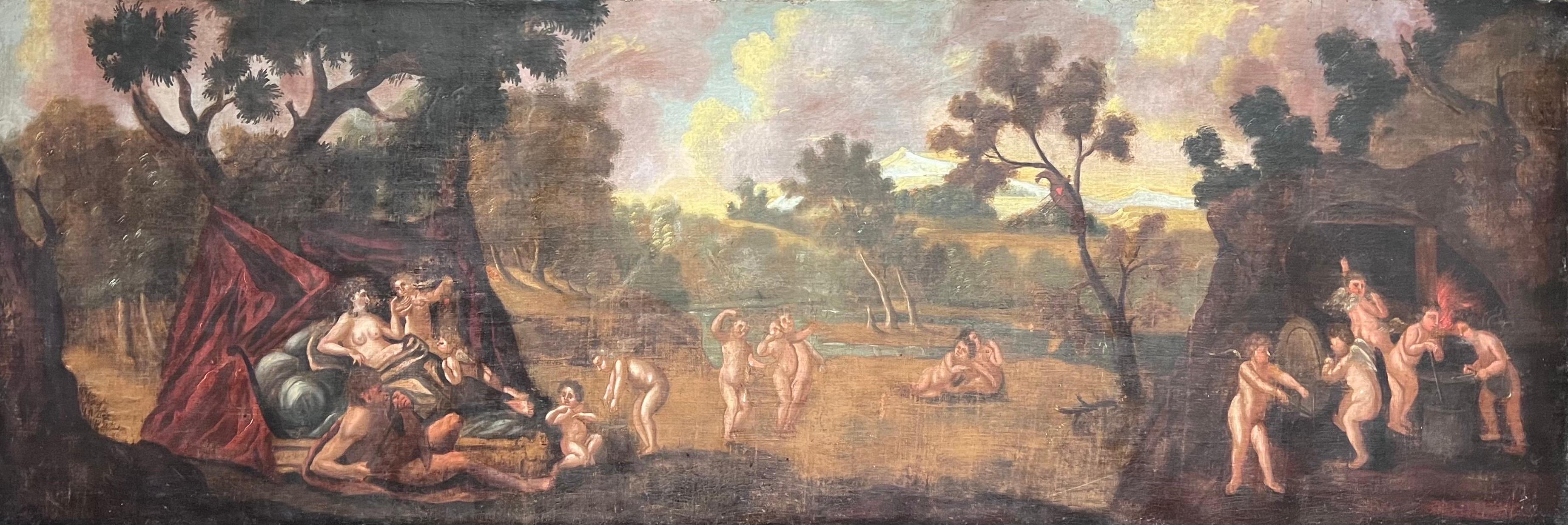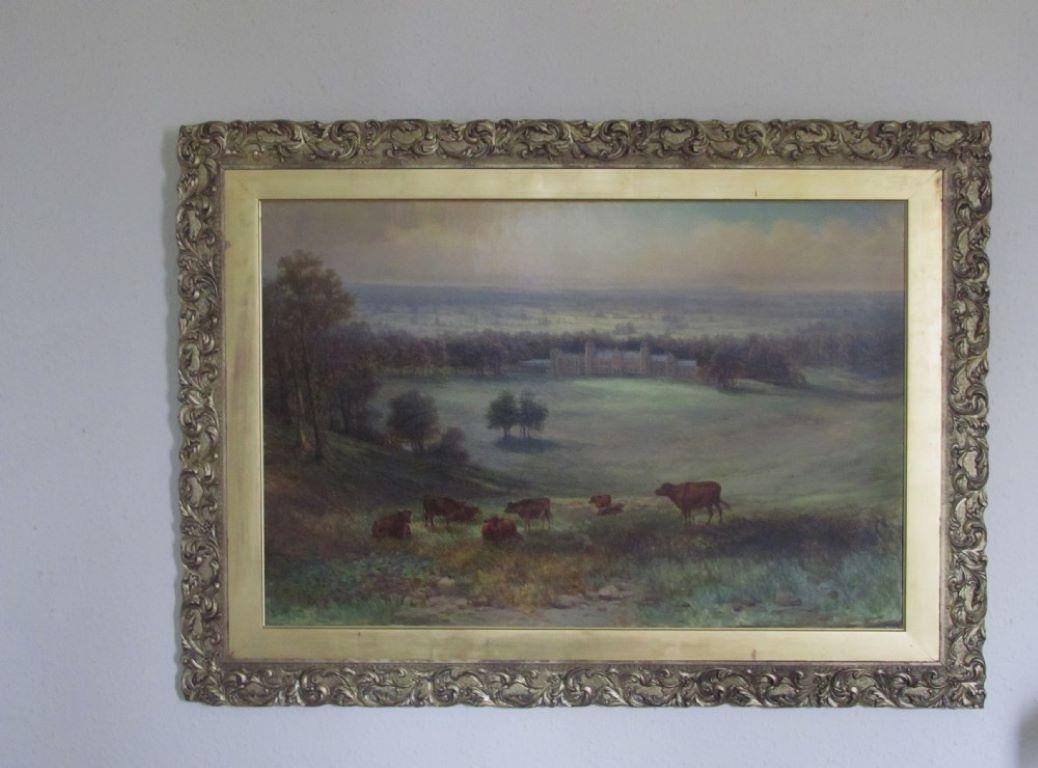Items Similar to Italian Arch - Old Master British art Italian landscape and ruins through arch
Want more images or videos?
Request additional images or videos from the seller
1 of 5
(Circle of) Hubert RobertItalian Arch - Old Master British art Italian landscape and ruins through archcirca 1890
circa 1890
About the Item
This lovely British 18th century landscape oil painting is attributed to circle of Hubert Robert or Robert of the Ruins as he was better known. The work depicts an extensive landscape as viewed through an arched building. Ivy and branches hang down the other side of the arch and columns can be seen to the left. The landscape disappears into the distance under a blue sky. A lovely painting typical of Hubert Robert in style and manner. In original untouched condition.
Provenance. Old auction chalk marks and old collectors red wax seal. Sussex estate.
Condition. Oil on canvas, 14 inches by 11 inches unframed. A bit thin in places.
Framed in an original ebonised period frame, 19 inches by 16 inches framed.
One of the most prominent artists of his era, Hubert Robert (1733-1808) is perhaps best known today as “Robert of the Ruins,” the nickname bestowed on him by the eighteenth-century philosopher, critic, and encyclopaedist Denis Diderot. Indeed, Robert loved and depicted ruined structures of all types, whether real or imagined, and not just those of ancient Rome (he lived in Italy for eleven years). He also drew inspiration from scenes he encountered in his native France, including urban renewal projects, Gallo-Roman antiquities, and natural disasters. At the core of his success was his brilliance as a master of the architectural capriccio, in which random monuments from different locales were artfully brought together to create new, completely imaginary landscapes.
In addition to being a talented landscape painter, Robert was a gifted and prolific draftsman, an engaging printmaker, an interior decorator, and a garden designer. Lively, intelligent, and much sought after, this good-humored, well-loved bon vivant moved easily through the most exalted circles of Paris’s society, even though his own parents had been personal attendants in an aristocratic household. He later addressed the demise of this glittering world through representations of contemporary events such as the vandalizing of royalist monuments and the destruction of the Bastille prison during the French Revolution. Imprisoned himself, he narrowly escaped the guillotine and upon his release completed a series of meditative depictions of the newly created Musée du Louvre, where he served as curator until his death in 1808.
- Creator:(Circle of) Hubert Robert (1733 - 1808, British)
- Creation Year:circa 1890
- Dimensions:Height: 19 in (48.26 cm)Width: 16 in (40.64 cm)Depth: 2 in (5.08 cm)
- Medium:
- Movement & Style:
- Period:
- Condition:
- Gallery Location:London, GB
- Reference Number:1stDibs: LU853113014852
About the Seller
5.0
Platinum Seller
These expertly vetted sellers are 1stDibs' most experienced sellers and are rated highest by our customers.
1stDibs seller since 2018
402 sales on 1stDibs
Typical response time: 1 hour
- ShippingRetrieving quote...Ships From: London, United Kingdom
- Return PolicyA return for this item may be initiated within 14 days of delivery.
More From This SellerView All
- Amsterdam Harbour Scene with Figures Dutch 17th Century art marine oil paintingLocated in London, GBThis superb Dutch 17th century Golden Age Old Master cityscape oil painting of Amsterdam is by noted artist Jacobus Storck. Painted circa 1670, the composition is a Dutch Amsterdam h...Category
17th Century Old Masters Landscape Paintings
MaterialsOil
- Travellers and Carriage in Landscape Dutch 17th century Golden Age oil paintingLocated in London, GBThis superb Dutch Old Master Golden Age oil painting is attributed to Pieter Bodding van Laer. Painted circa 1635 the composition is a group of travellers who have stopped to rest. I...Category
17th Century Old Masters Landscape Paintings
MaterialsOil
- Shepherd with Animals in Landscape - Dutch Old Master art pastoral oil paintingBy Nicolaes BerchemLocated in London, GBThis lovely Dutch Old Master oil painting is attributed to noted Dutch artist Nicholaes Berchem. Painted circa 1665 it is a charming pastoral scene of a shepherd and his animals including sheep, goats, donkey and cows and of course his trusty dog. They are all resting beneath trees while he looks on attentively. The light in the sky and the light and shadows on the animals is beautiful. A really superb example of Dutch Old Master art with great detail. Provenance. Surrey estate. Christies stamp verso. Condition. Oil on canvas, 38 inches by 32 inches and in good condition. Frame. Housed in a complementary gilt frame, 46 inches by 30 inches and in good condition. Nicolaes Pieterszoon Berchem (1620-1683) was a highly esteemed and prolific Dutch Golden Age painter of pastoral landscapes, populated with mythological or biblical figures, but also of a number of allegories and genre pieces. He was a member of the second generation of "Dutch Italianate landscape" painters. These were artists who travelled to Italy, or aspired to, in order to soak up the romanticism of the country, bringing home sketchbooks full of drawings of classical ruins and pastoral imagery. His paintings, of which he produced an immense number, (Hofstede de Groot claimed around 850, although many are misattributed), were in great demand, as were his 80 etchings and 500 drawings. His landscapes, painted in the Italian style of idealized rural scenes, with hills, mountains, cliffs and trees in a golden dawn are sought after. Berchem also painted inspired and attractive human and animal figures (staffage) in works of other artists, like Allaert van Everdingen, Jan Hackaert, Gerrit Dou, Meindert Hobbema and Willem Schellinks. Born in Haarlem, he received instruction from his father Pieter Claesz, and from the painters Jan van Goyen, Pieter de Grebber, Jan Baptist Weenix, Jan Wils and Claes Cornelisz. Moeyaert. According to Houbraken, Carel de Moor told him that Berchem got his name from two words "Berg hem" for "Save him!", an expression used by his fellows in Van Goyen's workshop whenever his father chased him there with the intent to beat him. No trip or Grand Tour by Berchem was documented by Houbraken though he mentioned another story about the "Berg hem!" nickname which came from Berchem's conscription as a sailor; the man in charge of impressment knew him and sent him ashore with the words "Save him!". Today his name is assumed to come from his father's hometown of Berchem, Antwerp. According to the RKD he traveled to Italy with Jan Baptist Weenix, whom he called his cousin, in 1642–5. Works by him are signed both as "CBerghem" and "Berchem". In 1645 he became a member of the Dutch reformed church and married the year after. According to Houbraken he married the daughter of the painter Jan Wils, who kept him on a short allowance, but to finance his collection of prints he would borrow money from his pupils and colleagues and pay them back from the proceeds of paintings that he didn't tell her about. Around 1650 he travelled to Westphalia with Jacob van Ruisdael, where a dated piece showing Burg Bentheim is recorded. Maybe Berchem went to Italy after this trip and before he moved to Amsterdam - he is not clearly documented in the Netherlands between 1650 and 1656. Around 1660 he worked for the engraver Jan de Visscher designing an atlas. In 1661-1670 he is registered in Amsterdam and in 1670 he moved back to Haarlem, but was living back in Amsterdam by 1677, where he died in 1683. He was a popular teacher and his pupils were Abraham Begeyn, Johannes van der Bent, his son Nicolaes, Isaack Croonenbergh, Simon Dubois, Karel Dujardin, Johannes Glauber, Pieter de Hooch, Jacob van Huchtenburg, Justus van Huysum...Category
17th Century Old Masters Landscape Paintings
MaterialsOil
- Arcadian Italian Landscape - Old Master 17thC French oil painting herdsman sheepBy (Attributed to) Gaspard DughetLocated in London, GBA delicate oil on canvas landscape capriccio of an Arcadian landscape with figures and sheep and goats in the foreground. A stormy sky and blasted tree populate the landscape and the...Category
17th Century Old Masters Landscape Paintings
MaterialsOil
- Dutch Marine Shipping Seascape - Golden Age art Old Master oil painting boatsLocated in London, GBThis superb Dutch Old Master marine oil painting is attributed to the circle of Jacob de Heusch. Painted circa 1690 the setting is an Italian coast with fisherfolk in the foreground....Category
17th Century Old Masters Landscape Paintings
MaterialsOil
- Peacock and Birds in a Landscape - British 17thC Old Master animal oil paintingBy Marmaduke CradockLocated in London, GBThis stunning British Old Master oil painting is attributed to circle of noted bird painter Marmaduke Cradock. Painted circa 1690 it is an excellent example and the sort of collection of birds he loved to paint - a peacock, wild turkeys, a jay in the foreground and doves, all set in a beautiful landscape. A variant of this painting is now in The Tate collection. Unlike many artists, he preferred to paint live birds with all their passions, joys and quarrels. The artist has perfectly capture the dynamics between this group, especially the dove and jay, as they all begin to settle down in the twilight. The colouring and brushwork are superb making this a fantastic British Old Master bird oil painting in a stunning carved gilt frame. Provenance. London estate. Condition. Oil on canvas, 42 inches by 39 inches and in good condition. Frame. Housed in a magnificent complementary period carved and gilded frame, 50 inches by 47 inches and in good condition. Marmaduke Cradock (1660-1716) was an English painter of birds and animals. Some older sources give his first name as Luke. Cradock was an English painter, noted for his depictions of birds, dead game, and other animals. He was born in Somerton, Somerset and moved to London, where he served an apprenticeship to a house-painter. He was, however, self-taught as an artist, becoming skilled in the depiction of birds and animals. Horace Walpole wrote that "I have seen some pieces by his hand which he painted with a freedom and a fire that entitled them to more distinction". According to Walpole, Cradock deliberately shunned aristocratic patronage. He worked in general by the day, and for dealers who retailed his works; possessing that conscious dignity of talent which made him hate to be employed by men whose birth and fortune confined his fancy, and restrained his freedom. According to the RKD his work as a still life and bird painter was influenced by Melchior d'Hondecoeter, Peter Frans Casteels, and Jakob Bogdani. Sketches in the collection of the British Museum indicate that he based at least some of the birds in his paintings on drawings from life. He tended to paint domestic birds and common wild species, rather than the exotic varieties favoured by some other artists. He sometimes introduced elements of drama such as attacks by predatory animals into his bird paintings, a feature shared with the works of Francis Barlow...Category
17th Century Old Masters Animal Paintings
MaterialsOil
You May Also Like
- William sidney cooper, Cows by a river 19th century landscape oilBy William Sidney CooperLocated in York, GBA fine framed oil on canvas painting by the renowned artist William Sidney coope.Signed and dated 91 lower left. This painting depicts 3 cows resting by a river, a village with hous...Category
19th Century Old Masters Landscape Paintings
MaterialsOil
- Attributed to John Riley, 17th century English portrait of a girl on a terraceBy John RileyLocated in Bath, SomersetPortrait of a young girl, full-length, wearing a blue silk gown, standing on a terrace beside a classical urn holding a branch with blossom. Attributed to John Riley...Category
17th Century Old Masters Portrait Paintings
MaterialsOil, Canvas
- View of Shipping on the River Avon from Durdham Down, near BristolLocated in Stoke, HampshireThomas Smith of Derby (c. 1710-1767) View of Shipping on the River Avon from Durdham Down, near Bristol, 1756 Oil on canvas Canvas size - 20 x 47 in Framed size - 26 x 53 in Provena...Category
18th Century Old Masters Landscape Paintings
MaterialsOil
- Huge Old Master Oil Painting 17th century Diana & Cupids in Panoramic LandscapeLocated in Cirencester, GloucestershireDiana The Huntress and her Cherubs Northern European artist, circa 1680's period oil on canvas, unframed canvas: 20 x 60.5 inches provenance: private collection, UK condition: some p...Category
17th Century Old Masters Figurative Paintings
MaterialsOil
- LES LAVEUSES, loire valley, french landscape scene, oil by Henri DutzchoildDLocated in York, GBA lovely tranquil scene of LES LAVEUSES. Depicting houses by a stream/river with a woman washing her laundry.Framed Oil on canvas Signed and dated '74'(lower right) The size being...Category
19th Century Old Masters Landscape Paintings
MaterialsOil
- 18th Century English Marine Oil Painting on Wood Panel Fishing Boats Stormy SeaLocated in Cirencester, GloucestershireStormy Seas English School, 18th century oil on thick wood panel, unframed panel: 25 x 30 inches provenance: private collection, East Anglia, England condition: very good and sound c...Category
18th Century Old Masters Landscape Paintings
MaterialsOil
